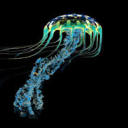
Bioluminescence is a chemical reaction that produces light. Many deep sea animals use bioluminescence. This blog is dedicated to educating the public about the amazing creatures that thrive in the deep sea.
57 posts
Latest Posts by bioluminescentoceangoddess - Page 2


Lav Polyp
leuckartiara octona
The Lav Polypo is a jelly that comes in a variety of colors and shapes; it dwells about 200m in the deep ocean. The red mass inside its translucent bell is the jelly’s reproductive organs. Furthermore, it uses its dull, yellow tentacles can catch unsuspecting prey.
Photo credit: https://www.pinterest.com/pin/65935582019848580/
https://www.petjellyfish.co.uk/shop/live-jellyfish/leuckartiara-octona


Mid-water Arctic Hydrozoan
Botrynema brucei
The Mid-water Arctic Hydrozoan is a mini-jelly that is transparent with hints of blue. It thrives in freezing cold temperatures and drifts aimlessly in the Artic Ocean. Moreover, it is only 3 cm in size and floats between 900m to 2,600m.
Photo credit: https://en.wikipedia.org/wiki/Botrynema_brucei
http://www.arcodiv.org/watercolumn/cnidarian/Botrynema_brucei.html
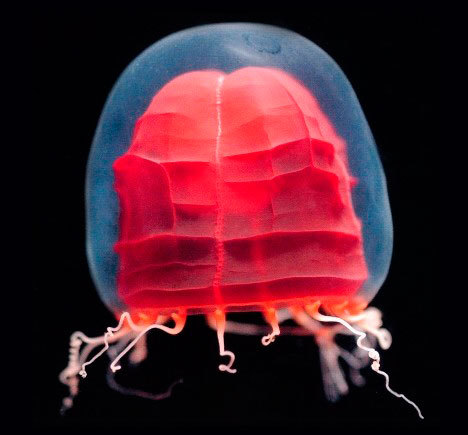

Red Paper Lantern Medusa
Pandea rubra
The Red Paper Lantern resembles a floating, Japanese paper lantern in the deep sea. It has the ability to crumple and wrinkle its bright, red bell, and it is located at depths between 550m to 1200m. It has also been nicknamed the “origami jelly.”
Photo credit: https://commons.wikimedia.org/wiki/Category:Pandea_rubra
http://www.thegorgeousdaily.com/pandea-rubra/
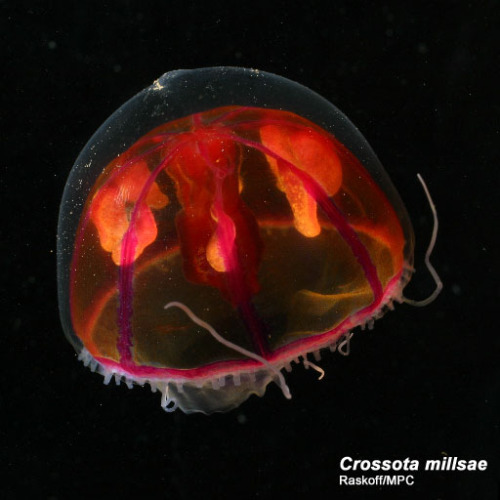
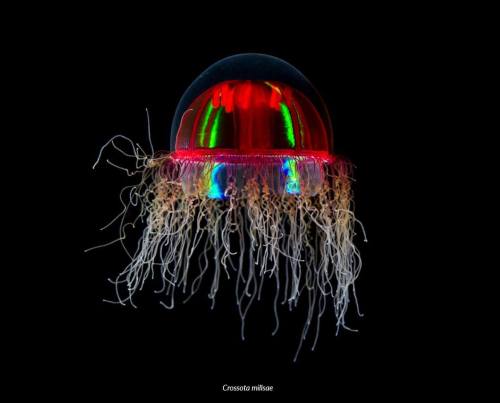
Psychedelic Medusa
Crossota millsae
The Psychedelic Medusa is a deep-sea hydrozoan that is abundant in the North Pacific. The mini-jelly is found at depths between 1000m to 3800m, and are often observed drifting near the ocean floor. It also has an eccentric reproduction behavior uncommon in cnidarians. The females display viviparity, and carry the babies in her bell until they are ready to hatch.
Photo credit: http://www.arcodiv.org/watercolumn/cnidarian/Crossota_millsae.html
https://twitter.com/spothvegr/status/1030177493075079169


Atolla Jelly
Atolla wyvillei
The Atolla Jelly is a fiery, red jellyfish that has an extraordinary display of bioluminescence. When the jelly is attacked, it uses bioluminescence to produce thousands of vibrant, blue flashes; the blue flashes act as an alarm, which draws in bigger predators and warns prey. The jelly can be found at depths between 600 m to 1500m, and it also has a long hypertrophied tentacle that aids in reproduction.
Photo credit: https://en.wikipedia.org/wiki/Atolla_jellyfish
https://en.wikipedia.org/wiki/Atolla_jellyfish

Black Medusa
Vampyrocrossota childressi
The Black Medusa is an inky, black hydrozoan that absorbs all light that hits its tiny body. It has a translucent gelatin and a black umbrella; it is also only 1.5 cm in size. Moreover, it is found at depths between 600m to 1500m, and it spends its entire life floating in the deep ocean.
Photo credit: https://www.pinterest.com/pin/488148047080475827/



Fangtooth
Anoplogaster cornuta
The Fangtooth is a ferocious predator that is found at depths between 600 m to 5000 m. It has large, needle like teeth that are used to catch prey. It also has extremely sensitive sensory canals underneath of its scales used to detect movement in the water. Furthermore, their preferred prey are crustaceans and fish.
Photo credit: https://pixels.com/featured/fangtooth-fish-dant-fenolio.html
https://www.pinterest.com/pin/845902742487789950/
https://www.newscientist.com/article/mg23231020-400-up-close-with-the-giant-teeth-of-the-deepsea-fangtooth/


Pigbutt worm
Chaetopterus pugaporcinus
The Pigbutt worm or the flying buttocks of the sea is spotted floating between 965 m to 1300 m in the deep ocean. It is actually a polychaete (polly-keet) worm species that burrows in the ground as an adult, and floats around the ocean as a baby. The worm feeds itself : by creating a balloon of mucus; collecting particles on the mucus; and then consuming the particles. It is the rarest and thickest worm in the deep ocean, for only ten have been spotted.
Photocredit: https://roaring.earth/pigbutt-worm/


Black-devil anglerfish
Melanoncetus johnsoni
The Black-devil anglerfish is a skilled predator that lurks in the darkness. It uses a bioluminescent organ, a top its head, to lure unsuspecting prey into its jaws. Even though these fish are terrifying to look at, they are about the size of a grape fruit. To save energy, they remain immobile in the water, yet they can detect even the slightest vibrations. Since finding a mate is hard at this depth, male fish will attach themselves to a female and slowly dissolve into her tissue; so she is able to use the sperm the male provides at any time. In addition, this is the fish that tried to eat Marlin and Dory in “Finding Nemo.”
Photo credit: https://underthevastblueseas.tumblr.com/post/40882487364/this-female-black-devil-anglerfish-with-her-flabby
https://www.pinterest.fr/pin/574631233709001328/


Googly-eyed glass squid
Teuthowenia pellucida
The Googly eyed squid is a rare oddity that is found in the southern hemisphere. It has a large, spherical head that is filled with water and teeny, tiny tentacles that help propel it through the water. If it comes across a predator, it deflates its head and draws its tentacles into its cavity. On the other hand, it may also fill the cavity with water to increase its size, and intimidate the predator. If all fails, it will ink and try to escape through the darkness. Furthermore, baby squids can be found at the surface (0-600m); then slowly migrate downwards as they mature into adults (1600-2500m).
Photo credit: http://animaladay.blogspot.com/2011/07/googly-eyed-glass-squid.html
https://faunafabula.tumblr.com/post/5999675353/googly-eyed-glass-squid-teuthowenia-pellucida
Sea sparkle is a common, bioluminescent plankton. Even though its not an animal, it is worth sharing.


Sea sparkle
Noctiluca scintillans
Sea sparkle is a bioluminescent dinoflagellate that blooms in many coastal waters. Sea sparkle feeds on plankton, diatoms, fish eggs, and other dinoflagellates. It also has a flagellum, or tiny tail, that helps it move around in the water. Even though sea sparkle is beautiful to witness at night, it is hazardous to other marine species and resembles a reddish-pink film during the day.
Photo credit:
https://alexandrathemb.tumblr.com/post/49814932878/noctilucas-scintillans-a-bioluminescent
https://thevelv.blogspot.com/2015/07/noctiluca-scintillans.html


Jewel Squid
Histioteuthis heteropsis
The Jewel Squid is covered in color-changing photophores that resemble sparkling gem stones. They also have a light-red coloration and are about 20 cm in length. They display a unique behavioral adaptation called diel migration. During the day, they stay at depths around 400-1200 m, and then surface during night (0-400m). This behavioral pattern is designed maximize feeding at night, and avoid predators during the day. The primary predator of the Jewel Squid is the Sperm Whale.
Photo credit: https://www.pinterest.com/pin/722827808920240115/
https://twitter.com/theoctonation/status/1168516522270253056
Pyrocystis fusiformis is a common plankton that produces bioluminescence. Not exactly a marine animal, but an amazing organism that produces bioluminescence. So, I thought it was worth sharing on this page.



Pyrocystis fusiformis
Pyrocystis Fusiformis is a marine dinoflagellate that is non-motile and has a short life cycle (5-7 days). When disturbed, the dinoflagellate displays vibrant, blue bioluminescence. The bioluminescence is design to startle grazers, or cause them to glow, making them more vulnerable to predators. During the day, it uses photosynthesis to produce its own food, and it produce bioluminescence at night. Furthermore, it fixes carbon from the ocean and produces oxygen for the marine animals that live there. All in all, I find this diamond shaped plankton to be unique and beautiful.
Photo credit: https://fineartamerica.com/featured/2-bioluminescence-of-pyrocystis-fusiformis-gerd-guentherscience-photo-library.html
https://exploringtheinvisible.com/2013/11/21/c-mould-new-acquisition-pyrocystis-fusiformis/
https://www.flickr.com/photos/13084997@N03/32823053106
If you are interested in learning about different types of plankton in the ocean, please check out @planktonqueen page. I post a lot of cool species, photos, and facts.

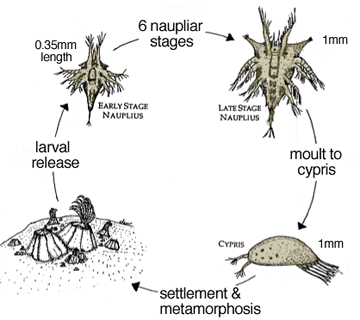
Barnacle Larvae
Amphibalanus eburneus
When we think of barnacles, we think of the hard, white crustaceans that grow on the side of boats and docks. However, barnacles go through a variety life stages and metamorphosis before they spend their life on a hard surface. The image above is a barnacle larvae when it is in the cypris stage, think of it as a baby barnacle. This larvae is an example of zooplankton and spends a short period of time floating around in the water column. The second image summarizes the life cycle of a barnacle.
Photo source: https://www.nyharbornature.com/blog/barnacles-are-reproducing
https://www.pinterest.com/pin/453174781229895797/


Pink Helmet
Aglantha digitale
The Pink Helmet is a mini hydromedusa that comes in a variety of vibrant colors. The tiny jelly is only 4 cm in size and is found towards the surface of the ocean. The purple and blue hues we see in its bell are caused by a phenomenon known as iridescence, when light strikes the jelly’s thin tissue at different angles (similar to what we see in a soap bubbles). It also has orange pigmentation near its mouth; this pigmentation helps attract prey and mask luminescence. Furthermore, females tend to be more colorful than males.
Photo credit: https://biolum.eemb.ucsb.edu/organism/pictures/aglantha.html
https://www.pinterest.com/pin/186899453255850798/


Piglet Squid
Helicocranchia pfefferi
The Piglet Squid is a very small and delicate, transparent squid. It is found at depths between 400 to 1000 m. It has an unique siphon that is used for jet propulsion and it resembles a pig muzzle. The young piglet squids tend to live close to the surface, and steadily migrates downward as they grow. This behavior is called ontogenetic migration.
Photo credit: http://photo.cctv.com/2019/07/23/PHOAKMEBh8xJRaHXEUIGx8kE190723.xml
https://www.ourbreathingplanet.com/banded-piglet-squid/

Glass Octopus
Vitreledonella richardi
The Glass Octopus spend its entire life in the midwater section of the ocean and found at depths between 200m to 2000m. Even though it has no protection from predators, it achieves perfect transparency. The only part of the Glass Octopus that is visible is its digestive gland. However, the digestive gland is placed vertically to minimize detection. In addition, I find this octopus to be super cute!
Photo credit: https://www.mynumer.com/forums/topic/499/invisible-animals/view/post_id/859

Black- eyed squid
Gonatus onyx
The Black-eyed Squid is roughly over one foot (35 am) and is found at depths as deep as 2500m. The female Black-eyed Squid works fiercely to protect her babies, by carrying around a patch of egg for six to nine months. When the eggs hatch, 2000 to 3000 babies are released into the ocean. However, this makes her vulnerable to predators.
Photocredit: http://tolweb.org/Gonatus+onyx/19769


Blacksnout Seasnail
Paralipparis copei copei
The Blacksnout Seasnail may not look like a snail, but it does have a slimy, gelatinous substance that covers its body. It can be found at depths between 200 m to 1692 m, and adults grow up to be 17 cm in size (approximately 6.5 in). It also has an elongated body that resembles an eel. Furthermore, it can be seen rolling itself in a loop; this behavior is a defensive posture that makes it appear like a jelly. In the darkness, predators tend to avoid the Blacksnout Seasnail because its often mistaken as a hunter due to its appearance and behavior.


Giant Bell Jelly
Scrippsia pacifica
The Giant Belly Jelly has 256 tentacles attached to a gelatinous bell-shaped base. Like most cnidarians, the Giant Belly Jelly uses specialized stinging cells called nematocysts to catch its prey. When fish and other prey swim into its tentacles, the sensory projection on the cnidocyte (cell that holds the nematocysts) is activated. Then the nematocysts and barb are released, hitting the vulnerable prey and releasing a toxin into the prey’s body. The Giant Bell Jelly is found at 400 m in the ocean. It is related to the jellyfish, but it is categorized as a Hydrozoa (similar to the Portuguese- man-o-war)
https://vimeo.com/42551565
Photo Credit: https://www.pinterest.cl/pin/467107792572034837/
https://courses.lumenlearning.com/ivytech-bio1-1/chapter/phylum-cnidaria/


Cockatoo Squid
Galiteuthis phyllura
The Cockatoo squid is a highly-specialized oddity of the deep ocean and found at depths between 300 to 1400 m. It is completely transparent, except for its eyes. It also has bioluminescent photophores that are directed downward: this makes it difficult for deep sea predators to see the Cockatoo Squid. It was named after the Cockatoo because it holds its tentacles above its head, resembling the bird. The Cockatoo squid can also get fairly large with adults reaching lengths of 2.7 meters (over 6 ft.)
Photocredit: https://www.americanscientist.org/article/at-home-in-the-dark
https://www.pinterest.com/pin/28710516347382519/

Vampire Squid
Vampyroteuthis infernalis
Even though the Vampire Squid is named after a notorious monster, this gentle creature does not live up to its name. It is only a foot long and occupies depths between 650m to 1500m in the deep ocean. Unlike other squids, it has reduced musculature and collects particles in the water column. However, it is capable of huge bursts of speeds. It uses bioluminescence to confuse both predators.
Photo credit: https://ocean.si.edu/ocean-life/invertebrates/vampire-squid-hell

Sea Angel
Cliopsis krohni
The Sea Angel is a tiny snail that is only 4 cm in length and found at depths as deep as 1500 m. Even though it is small, it is a viscous predator. It hunts other midwater snails using a structure called a radula. Unlike other snails, the Sea Angel’s mouth is located on top of its head. It also uses swimming “wings” to propel through the water.
Photo Source: http://seaslugsofhawaii.com/species/Cliopsis-krohni-a.html


Spookfish
Winteria telescopa
The Spookfish’s eyes act as a telescope and are designed to maximize light in the deep ocean. Its eyes contain rod cells that help distinguish between ambient light and bioluminescent light. This adaptation helps avoid predators and catch prey.
Picture Credit: https://www.natureplprints.com/deep-sea/deep-sea-fish-winteria-telescopa-15230734.html


Pacific Viperfish
Chauliodus macouni
The Pacific Viperfish looks intimidating with its sharp, pointy teeth and large jaws. However, its body is small and elongated. It can be found at depths ranging from 250m to 4390m. The Pacific Viperfish long teeth are an unique adaptation designed to keep prey trapped, but it is dangerously close to its eyes. There have been instances when they have caught prey that are too large to swallow and it dies along with its last meal. The Pacific Viper also has photophores along its body and a light organ near its dorsal fin. These organs exhibit bioluminescence and help with attracting pray: as well as, communicating with mates and confuse predators. It is one of the most ferocious predators of the deep ocean.
Photo credit: https://www.science-rumors.com/top-20-pacific-viperfish-facts-to-know-what-this-creature-is/
https://goldfisho.com/everything-you-need-to-know-about-viperfish/

Predatory Copepod
Paraeuchaeta barbata
Copepods are a type of zooplankton or tiny creature that feeds larger animals in the ocean such as, fish. They are crustaceans that have two long antennas and a sensory eye called an ocelli, which can only sense light. This copepod is located between 200m to 1500 m in the deep ocean. You may notice the copepod is red in color. The color is an adaptation that makes it difficult for predators to see the copepod because red wave lengths do not penetrate this depth (mostly blue and indigo light). Even though this creature tiny, it is a vital food source for many animals in the abyssal zone of the ocean.
Photo credit: http://www.arcodiv.org/watercolumn/copepod/Paraeuchaeta_barbata_large.html


Glowing sucker octopus
Stauroteuthis syrtensis
The Glowing Sucker Octopus can be found at 2500 m in the deep ocean. This unique creature has two fins that look similar to elephant ears. They move elegantly through the water by moving these fins and contracting their mantle. Evidence of this creature has only been spotted in the Atlantic Ocean.
Photo credit: https://octolab.tv/species/glowing-sucker-octopus/
https://ferrebeekeeper.wordpress.com/2011/03/14/glowing-sucker-octopus/